Hongjun Wang
Senior member, IEEE
Not All Degradations Are Equal: A Targeted Feature Denoising Framework for Generalizable Image Super-Resolution
Sep 18, 2025Abstract:Generalizable Image Super-Resolution aims to enhance model generalization capabilities under unknown degradations. To achieve this goal, the models are expected to focus only on image content-related features instead of overfitting degradations. Recently, numerous approaches such as Dropout and Feature Alignment have been proposed to suppress models' natural tendency to overfit degradations and yield promising results. Nevertheless, these works have assumed that models overfit to all degradation types (e.g., blur, noise, JPEG), while through careful investigations in this paper, we discover that models predominantly overfit to noise, largely attributable to its distinct degradation pattern compared to other degradation types. In this paper, we propose a targeted feature denoising framework, comprising noise detection and denoising modules. Our approach presents a general solution that can be seamlessly integrated with existing super-resolution models without requiring architectural modifications. Our framework demonstrates superior performance compared to previous regularization-based methods across five traditional benchmarks and datasets, encompassing both synthetic and real-world scenarios.
MultiEdit: Advancing Instruction-based Image Editing on Diverse and Challenging Tasks
Sep 18, 2025Abstract:Current instruction-based image editing (IBIE) methods struggle with challenging editing tasks, as both editing types and sample counts of existing datasets are limited. Moreover, traditional dataset construction often contains noisy image-caption pairs, which may introduce biases and limit model capabilities in complex editing scenarios. To address these limitations, we introduce MultiEdit, a comprehensive dataset featuring over 107K high-quality image editing samples. It encompasses 6 challenging editing tasks through a diverse collection of 18 non-style-transfer editing types and 38 style transfer operations, covering a spectrum from sophisticated style transfer to complex semantic operations like person reference editing and in-image text editing. We employ a novel dataset construction pipeline that utilizes two multi-modal large language models (MLLMs) to generate visual-adaptive editing instructions and produce high-fidelity edited images, respectively. Extensive experiments demonstrate that fine-tuning foundational open-source models with our MultiEdit-Train set substantially improves models' performance on sophisticated editing tasks in our proposed MultiEdit-Test benchmark, while effectively preserving their capabilities on the standard editing benchmark. We believe MultiEdit provides a valuable resource for advancing research into more diverse and challenging IBIE capabilities. Our dataset is available at https://huggingface.co/datasets/inclusionAI/MultiEdit.
Unsupervised Multi-Attention Meta Transformer for Rotating Machinery Fault Diagnosis
Sep 11, 2025Abstract:The intelligent fault diagnosis of rotating mechanical equipment usually requires a large amount of labeled sample data. However, in practical industrial applications, acquiring enough data is both challenging and expensive in terms of time and cost. Moreover, different types of rotating mechanical equipment with different unique mechanical properties, require separate training of diagnostic models for each case. To address the challenges of limited fault samples and the lack of generalizability in prediction models for practical engineering applications, we propose a Multi-Attention Meta Transformer method for few-shot unsupervised rotating machinery fault diagnosis (MMT-FD). This framework extracts potential fault representations from unlabeled data and demonstrates strong generalization capabilities, making it suitable for diagnosing faults across various types of mechanical equipment. The MMT-FD framework integrates a time-frequency domain encoder and a meta-learning generalization model. The time-frequency domain encoder predicts status representations generated through random augmentations in the time-frequency domain. These enhanced data are then fed into a meta-learning network for classification and generalization training, followed by fine-tuning using a limited amount of labeled data. The model is iteratively optimized using a small number of contrastive learning iterations, resulting in high efficiency. To validate the framework, we conducted experiments on a bearing fault dataset and rotor test bench data. The results demonstrate that the MMT-FD model achieves 99\% fault diagnosis accuracy with only 1\% of labeled sample data, exhibiting robust generalization capabilities.
What Can We Learn from Harry Potter? An Exploratory Study of Visual Representation Learning from Atypical Videos
Aug 29, 2025Abstract:Humans usually show exceptional generalisation and discovery ability in the open world, when being shown uncommon new concepts. Whereas most existing studies in the literature focus on common typical data from closed sets, open-world novel discovery is under-explored in videos. In this paper, we are interested in asking: \textit{What if atypical unusual videos are exposed in the learning process?} To this end, we collect a new video dataset consisting of various types of unusual atypical data (\eg sci-fi, animation, \etc). To study how such atypical data may benefit open-world learning, we feed them into the model training process for representation learning. Focusing on three key tasks in open-world learning: out-of-distribution (OOD) detection, novel category discovery (NCD), and zero-shot action recognition (ZSAR), we found that even straightforward learning approaches with atypical data consistently improve performance across various settings. Furthermore, we found that increasing the categorical diversity of the atypical samples further boosts OOD detection performance. Additionally, in the NCD task, using a smaller yet more semantically diverse set of atypical samples leads to better performance compared to using a larger but more typical dataset. In the ZSAR setting, the semantic diversity of atypical videos helps the model generalise better to unseen action classes. These observations in our extensive experimental evaluations reveal the benefits of atypical videos for visual representation learning in the open world, together with the newly proposed dataset, encouraging further studies in this direction.
Panoptic Captioning: Seeking An Equivalency Bridge for Image and Text
May 22, 2025Abstract:This work introduces panoptic captioning, a novel task striving to seek the minimum text equivalence of images. We take the first step towards panoptic captioning by formulating it as a task of generating a comprehensive textual description for an image, which encapsulates all entities, their respective locations and attributes, relationships among entities, as well as global image state.Through an extensive evaluation, our work reveals that state-of-the-art Multi-modal Large Language Models (MLLMs) have limited performance in solving panoptic captioning. To address this, we propose an effective data engine named PancapEngine to produce high-quality data and a novel method named PancapChain to improve panoptic captioning. Specifically, our PancapEngine first detects diverse categories of entities in images by an elaborate detection suite, and then generates required panoptic captions using entity-aware prompts. Additionally, our PancapChain explicitly decouples the challenging panoptic captioning task into multiple stages and generates panoptic captions step by step. More importantly, we contribute a comprehensive metric named PancapScore and a human-curated test set for reliable model evaluation.Experiments show that our PancapChain-13B model can beat state-of-the-art open-source MLLMs like InternVL-2.5-78B and even surpass proprietary models like GPT-4o and Gemini-2.0-Pro, demonstrating the effectiveness of our data engine and method. Project page: https://visual-ai.github.io/pancap/
NTIRE 2025 Challenge on Day and Night Raindrop Removal for Dual-Focused Images: Methods and Results
Apr 19, 2025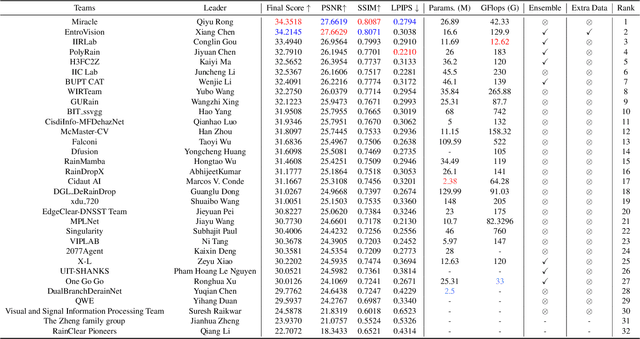
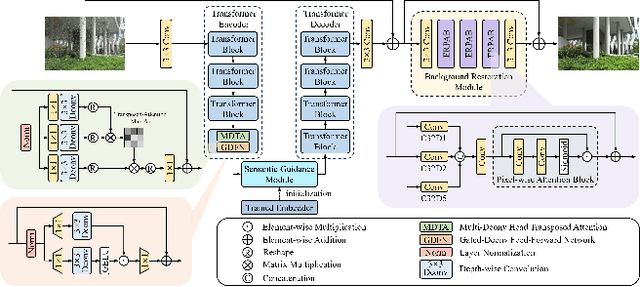
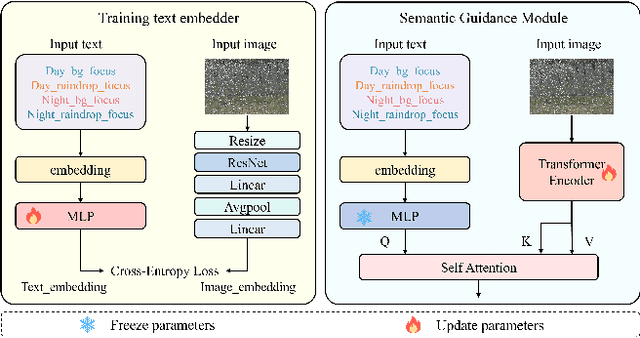
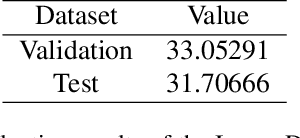
Abstract:This paper reviews the NTIRE 2025 Challenge on Day and Night Raindrop Removal for Dual-Focused Images. This challenge received a wide range of impressive solutions, which are developed and evaluated using our collected real-world Raindrop Clarity dataset. Unlike existing deraining datasets, our Raindrop Clarity dataset is more diverse and challenging in degradation types and contents, which includes day raindrop-focused, day background-focused, night raindrop-focused, and night background-focused degradations. This dataset is divided into three subsets for competition: 14,139 images for training, 240 images for validation, and 731 images for testing. The primary objective of this challenge is to establish a new and powerful benchmark for the task of removing raindrops under varying lighting and focus conditions. There are a total of 361 participants in the competition, and 32 teams submitting valid solutions and fact sheets for the final testing phase. These submissions achieved state-of-the-art (SOTA) performance on the Raindrop Clarity dataset. The project can be found at https://lixinustc.github.io/CVPR-NTIRE2025-RainDrop-Competition.github.io/.
Robustifying Fourier Features Embeddings for Implicit Neural Representations
Feb 08, 2025Abstract:Implicit Neural Representations (INRs) employ neural networks to represent continuous functions by mapping coordinates to the corresponding values of the target function, with applications e.g., inverse graphics. However, INRs face a challenge known as spectral bias when dealing with scenes containing varying frequencies. To overcome spectral bias, the most common approach is the Fourier features-based methods such as positional encoding. However, Fourier features-based methods will introduce noise to output, which degrades their performances when applied to downstream tasks. In response, this paper initially hypothesizes that combining multi-layer perceptrons (MLPs) with Fourier feature embeddings mutually enhances their strengths, yet simultaneously introduces limitations inherent in Fourier feature embeddings. By presenting a simple theorem, we validate our hypothesis, which serves as a foundation for the design of our solution. Leveraging these insights, we propose the use of multi-layer perceptrons (MLPs) without additive
Parallel Sequence Modeling via Generalized Spatial Propagation Network
Jan 21, 2025



Abstract:We present the Generalized Spatial Propagation Network (GSPN), a new attention mechanism optimized for vision tasks that inherently captures 2D spatial structures. Existing attention models, including transformers, linear attention, and state-space models like Mamba, process multi-dimensional data as 1D sequences, compromising spatial coherence and efficiency. GSPN overcomes these limitations by directly operating on spatially coherent image data and forming dense pairwise connections through a line-scan approach. Central to GSPN is the Stability-Context Condition, which ensures stable, context-aware propagation across 2D sequences and reduces the effective sequence length to $\sqrt{N}$ for a square map with N elements, significantly enhancing computational efficiency. With learnable, input-dependent weights and no reliance on positional embeddings, GSPN achieves superior spatial fidelity and state-of-the-art performance in vision tasks, including ImageNet classification, class-guided image generation, and text-to-image generation. Notably, GSPN accelerates SD-XL with softmax-attention by over $84\times$ when generating 16K images.
Unveiling the Inflexibility of Adaptive Embedding in Traffic Forecasting
Nov 18, 2024



Abstract:Spatiotemporal Graph Neural Networks (ST-GNNs) and Transformers have shown significant promise in traffic forecasting by effectively modeling temporal and spatial correlations. However, rapid urbanization in recent years has led to dynamic shifts in traffic patterns and travel demand, posing major challenges for accurate long-term traffic prediction. The generalization capability of ST-GNNs in extended temporal scenarios and cross-city applications remains largely unexplored. In this study, we evaluate state-of-the-art models on an extended traffic benchmark and observe substantial performance degradation in existing ST-GNNs over time, which we attribute to their limited inductive capabilities. Our analysis reveals that this degradation stems from an inability to adapt to evolving spatial relationships within urban environments. To address this limitation, we reconsider the design of adaptive embeddings and propose a Principal Component Analysis (PCA) embedding approach that enables models to adapt to new scenarios without retraining. We incorporate PCA embeddings into existing ST-GNN and Transformer architectures, achieving marked improvements in performance. Notably, PCA embeddings allow for flexibility in graph structures between training and testing, enabling models trained on one city to perform zero-shot predictions on other cities. This adaptability demonstrates the potential of PCA embeddings in enhancing the robustness and generalization of spatiotemporal models.
Learning to Balance: Diverse Normalization for Cloth-Changing Person Re-Identification
Oct 14, 2024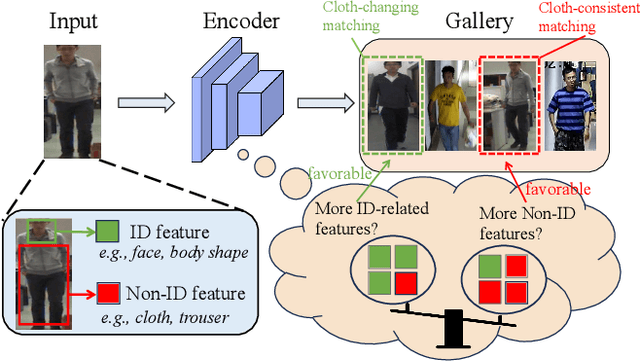

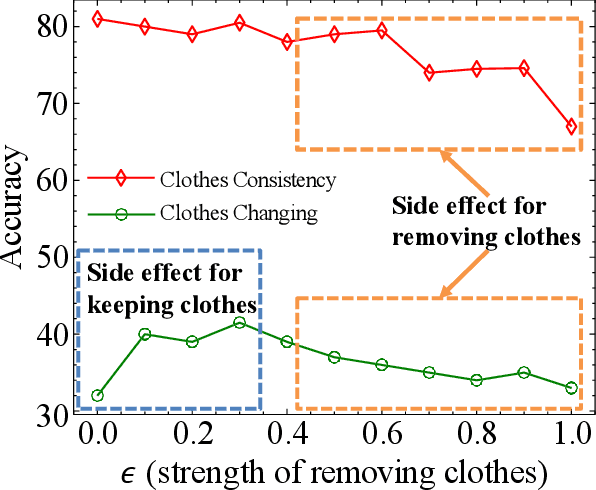

Abstract:Cloth-Changing Person Re-Identification (CC-ReID) involves recognizing individuals in images regardless of clothing status. In this paper, we empirically and experimentally demonstrate that completely eliminating or fully retaining clothing features is detrimental to the task. Existing work, either relying on clothing labels, silhouettes, or other auxiliary data, fundamentally aim to balance the learning of clothing and identity features. However, we practically find that achieving this balance is challenging and nuanced. In this study, we introduce a novel module called Diverse Norm, which expands personal features into orthogonal spaces and employs channel attention to separate clothing and identity features. A sample re-weighting optimization strategy is also introduced to guarantee the opposite optimization direction. Diverse Norm presents a simple yet effective approach that does not require additional data. Furthermore, Diverse Norm can be seamlessly integrated ResNet50 and significantly outperforms the state-of-the-art methods.
 Add to Chrome
Add to Chrome Add to Firefox
Add to Firefox Add to Edge
Add to Edge